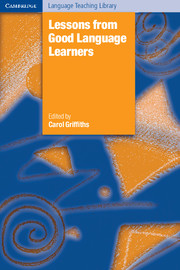Book contents
- Frontmatter
- Contents
- List of contributors
- Acknowledgements
- Editor's overview
- Prologue
- Reflections
- Part I Learner variables
- Part II Learning variables
- 12 Vocabulary and good language learners
- 13 Grammar and good language learners
- 14 Functions and good language learners
- 15 Pronunciation and good language learners
- 16 Listening and good language learners
- 17 Speaking and good language learners
- 18 Reading and good language learners
- 19 Writing and good language learners
- 20 Teaching/learning method and good language learners
- 21 Strategy instruction and good language learners
- 22 Errors correction and good language learners
- 23 Tasks and good language learners
- The learners' landscape and journey: a summary
- Index
22 - Errors correction and good language learners
Published online by Cambridge University Press: 11 August 2009
- Frontmatter
- Contents
- List of contributors
- Acknowledgements
- Editor's overview
- Prologue
- Reflections
- Part I Learner variables
- Part II Learning variables
- 12 Vocabulary and good language learners
- 13 Grammar and good language learners
- 14 Functions and good language learners
- 15 Pronunciation and good language learners
- 16 Listening and good language learners
- 17 Speaking and good language learners
- 18 Reading and good language learners
- 19 Writing and good language learners
- 20 Teaching/learning method and good language learners
- 21 Strategy instruction and good language learners
- 22 Errors correction and good language learners
- 23 Tasks and good language learners
- The learners' landscape and journey: a summary
- Index
Summary
Over the years, various teaching and learning methods have approached errorsin language learning from quite different theoretical and practical standpoints. An ongoing problem is a definition of “error.” Should an error be related to native-speaker utterances, as suggested by Lennon (1991)? Although defining error in these terms has some appeal, there is wide variation among those who would consider themselves to be native speakers, so whose variety is to be taken as the standard? Or should an error be judged according to whether it is grammatically correct or whether it is acceptable, as discussed by James (1998)? Although grammar may be a relatively objective criterion, able to be decided upon by some higher authority such as a reference grammar book, what is accepted as “correct” is by no means absolutely uniform across language varieties, while acceptability is a highly subjective measure. In spite of many years of debate, a review of the literature reveals that there is no “unproblematic” (Ellis and Barkhuizen, 2005, p. 56) definition of error.
The behaviorist view
The behaviorist approach to language learning expounded by Skinner (1957) saw language learning as a process of habit formation – the acquisition of a series of responses to external stimuli developed through a process referred to as operant conditioning. Under this approach language errors were considered to be counter-productive because they led to the formation of bad habits, which, if left uncorrected resulted in fossilization.
- Type
- Chapter
- Information
- Lessons from Good Language Learners , pp. 282 - 293Publisher: Cambridge University PressPrint publication year: 2008
- 5
- Cited by



